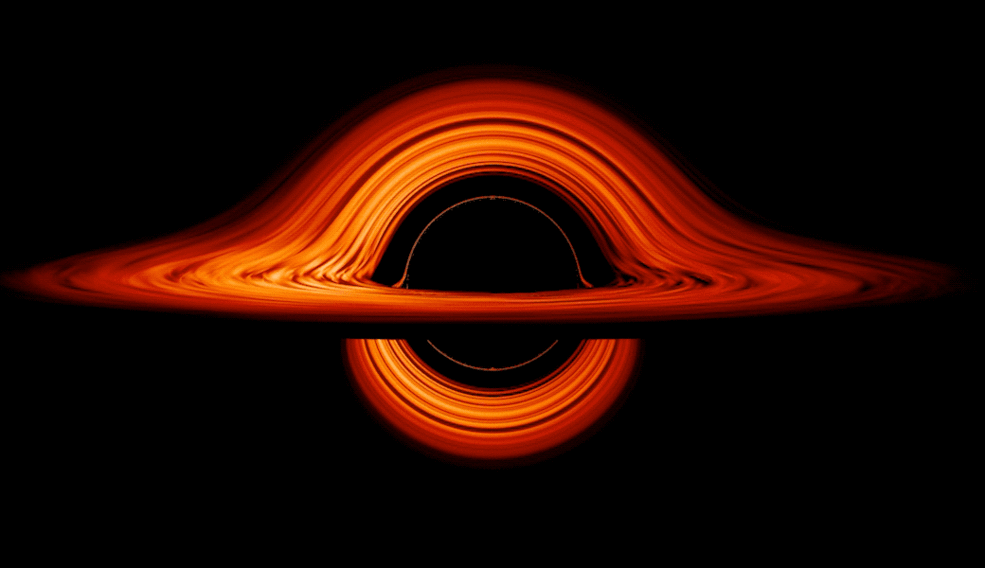NASA’s new black hole visualisation shows how gravity warps our view of them

NASA's visualisation of a black hole shows it is neither black, nor a hole. Photo: NASA's Goddard Space Flight Center/Jeremy Schnittman
NASA has released a spectacular visualisation of a black hole — the only thing is, it’s not black and it doesn’t even look like a hole.
So what are we looking at here?
Probably the most common misconception about black holes is that they’re not holes, said Andrew Penton of the University of Queensland, who’s studying supermassive black holes for his PhD.
“They’re spheres, just like a planet or a star,” he said.
A better way of thinking about a black hole is to imagine it being similar to a plughole.
All black holes have spin to some extent, although it’s an extremely hard thing to measure a lot of the time.
“So that’s why we get things called accretion discs, which are kind of like the whirlpool you get when you take a plug out,” Mr Penton said.
These accretion discs are the thin discs of matter that are spiralling and falling in towards the black hole in NASA’s visualisation.
Black holes are extremely dense, which means that when something gets close to a black hole it gets sucked right in.
“The unique thing about a black hole is that there’s a point at which nothing will be able to escape, not even light, which is why they’re black,” Mr Penton said.
This is called the black hole’s event horizon.
And as the visualisation shows, depending on the angle we’re viewing it from, the gravity of the black hole can distort our view of it.
This distortion is most pronounced when we’re looking at the black hole edge on.
Which is why we get this weird Saturn-type shape rather than a circle.
“What you’re seeing is because the gravity around this region of space is so great,” Mr Penton said.
The black hole is not just bending matter around it to make a disc, it’s bending light around it as well.
So the parts of the disc shown at the top and bottom of the image, are actually light from the parts of the disc from the far side of the black hole.
This light has been bent upwards and downwards really severely around the black hole so that it’s coming towards us.
It’s an example of gravitational lensing.
There are two REALLY cool things about this visualization.
1) The black hole bends space around it so you see the top AND bottom of the part of the disk BEHIND the black hole
2) The dark part (shadow) is where light is redirected away from you/INTO the BHhttps://t.co/4NJrMhP5OO— Katie Mack (@AstroKatie) September 30, 2019
“Light gets manipulated by gravity the same as matter does,” Mr Penton said.
“So you can get light doing really weird trajectories as long as you’ve got a large enough gravitational field in the middle.”
Another cool thing about the visualisation is how one side of the accretion disc is brighter than the other.
The effect is called Doppler beaming, said Mr Penton.
“It’s basically that light gets kind of an extra kick from the spin of the accretion disc more on one side than the other.”
As the disc is spinning in one direction, the matter moving towards us appears brighter than the matter that is moving away.
You’ll also noticed a ring of light sitting inside the accretion disc. This is known as the photon ring, composed of photons whizzing around at the speed of light.
Matter can’t get any closer than the edge of the accretion disc without falling into the black hole, a place called the innermost stable circular orbit.
Whereas photons travelling at the speed of light can sit in a closer stable orbit without getting sucked into the black hole.
Between the photon ring and the event horizon of the black hole is what’s known as the black hole’s shadow.
“When light that’s immediately around the black hole is trying to get past it can’t because it just gets sucked straight in,” Mr Penton said.
“Any photons that exist in that space will get sucked in before they get to us and we won’t ever be able to see them.”
Have I seen something like this before?
You might have, if you’ve seen the movie Interstellar.
The visualisation of Gargantua, the black hole in that movie, was based on real physics, Mr Penton said, and they used some of that same process to generate what it should look like.
“There’s some bits that were obviously tweaks for Hollywood, but the overall shape of what it would look like is actually relatively true to what we think.”
That’s the power of an accurate visualisation like NASA’s, Mr Penton said — it gives an easy way for the public to interact with what a black hole actually is, by making such a complicated thing easier to understand.
Besides, he added: “Black holes are really cool.”










